The Health Education Assets Library (HEAL) is a collection of over 22,000 freely available digital materials for health sciences education. The collection is now housed at the University of Utah J. Willard Marriott Digital Library.
TO
| Title | Description | Subject | Collection | ||
|---|---|---|---|---|---|
| 101 |
 |
Frontal plane QRS axis = -15 degrees | Frontal plane QRS axis = -15 degrees | Knowledge Weavers ECG | |
| 102 |
 |
Ventricular pacemaker rhythm | Note the small pacemaker spikes before the QRS complexes in many of the leads. In addition, the QRS complex in V1 exhibits ventricular ectopic morphology; i.e., there is a slur or notch at the beginning of the S wave, and>60ms delay from onset to QRS to nadir of S wave. This rules against a suprav... | Knowledge Weavers ECG | |
| 103 |
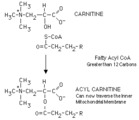 |
Acylation of carnitine by a long chain fatty acyl CoA | Long chain fatty acyl CoA cannot cross the inner mitochondrial membrane to participate in beta-oxidation. The fatty acyl group is therefore transferred to a carrier, carnitine, in a reversible reaction catalyzed by carnitine acyl transferase I. The resulting fatty acyl carnitine crosses the membra... | Knowledge Weavers Fatty Acids | |
| 104 |
 |
Diffuse anterolateral T wave abnormalities | Diffuse anterolateral T wave abnormalities | T Wave Abnormalities | Knowledge Weavers ECG |
| 105 |
 |
Four systems for denoting fatty acids | There are four commonly used ways of designating fatty acids. The first two columns show samples of names, and the last two columns show systems of abbreviating these names. | Nomenclature | Knowledge Weavers Fatty Acids |
| 106 |
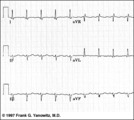 |
Frontal plane QRS axis = -45 degrees | Frontal plane QRS axis = -45 degrees | Knowledge Weavers ECG | |
| 107 |
 |
Marked sinus arrhythmia - marquette | Marked sinus arrhythmia - marquette | Knowledge Weavers ECG | |
| 108 |
 |
Muscle tremor artifact - marquette | Muscle tremor artifact - marquette | Knowledge Weavers ECG | |
| 109 |
 |
RBBB + LAFB: bifascicular block | RBBB + LAFB: bifascicular block | Knowledge Weavers ECG | |
| 110 |
 |
Reduction of 2-enoyl acyl carrier peptide | A 2-enoyl acyl group on the acyl carrier peptide is reduced by NADPH in a reaction catalyzed by enoyl acyl carrier peptide reductase. | Knowledge Weavers Fatty Acids | |
| 111 |
 |
ECG of the century: A most unusual 1st degree AV block | On Day 1, at a heart rate of 103 bpm the P waves are not clearly defined suggesting an accelerated junctional rhythm. However, on Day 2, at a slightly slower heart rate the sinus P wave suddenly appears immediately after the QRS complex. In retrospect, the sinus P wave in Day 1 was found burried i... | Knowledge Weavers ECG | |
| 112 |
 |
RBBB plus mobitz II 2nd degree AV block | The classic rSR' in V1 is RBBB. Mobitz II 2nd degree AV block is present because the PR intervals are constant. Statistically speaking, the location of the 2nd degree AV block is in the left bundle branch rather than in the AV junction. The last QRS in the top strip is a junctional escape, since... | Knowledge Weavers ECG | |
| 113 |
 |
Left axis deviation: QRS axis = -60 degrees | Lead aVR is isoelectric; leads II and III are mostly negative. The QRS axis, therefore, is -60 degrees. | Knowledge Weavers ECG | |
| 114 |
 |
QRS axis = +30 degrees | Lead III is isoelectric; leads I and II are positive. The QRS axis, therefore, is +30 degrees. | Knowledge Weavers ECG | |
| 115 |
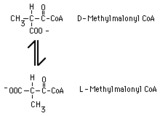 |
methylmalonyl CoA racemase reaction | In the metabolism of propionyl CoA, D-methylmalonyl CoA is produced by a carboxylase reaction. This product must be converted to L-methylmalonyl CoA in order to be metabolized further. The conversion is catalyzed by methylmalonyl CoA racemase. | Knowledge Weavers Fatty Acids | |
| 116 |
 |
Pacemaker failure to sense - marquette | Pacemaker failure to sense - marquette | Knowledge Weavers ECG | |
| 117 |
 |
Pacemaker fusion beat - marquette | Pacemaker fusion beat - marquette | Knowledge Weavers ECG | |
| 118 |
 |
RAE & RVH | RAE & RVH | Knowledge Weavers ECG | |
| 119 |
 |
Oxidation of a polyunsaturated fatty acid -- part I | The cycles of beta-oxidation prior to the one involving the original Delta-12 double bond act to get past the Delta-9 double bond. | Knowledge Weavers Fatty Acids | |
| 120 |
 |
Type II, 2nd degree sino-atrial block | Two types of 2nd degree SA block have been described. In type-I, or SA Wenckebach, the P-P interval of the pause is less than 2x the preceding P-P intervals. In type-II SA block the P-P interval of the pause is approximately 2x the normal P-P interval. The distinction between types I and II is no... | Knowledge Weavers ECG | |
| 121 |
 |
Bradycardia-dependent LBBB with carotid sinus massage | When carotid sinus massage slows the heart rate in this example, the QRS widens into a LBBB. This form of rate-dependent bundle branch block is thought to be due to latent pacemakers in the bundle undergoing phase 4 depolarization; when the sinus impulse enters the partially depolarized bundle, slow... | Knowledge Weavers ECG | |
| 122 |
 |
Atrial tachycardia with 3:2 AV block | In this rhythm the atrial rate from an ectopic focus is 160 bpm. Atrial activity can be seen on top of T waves, and before QRS's. Careful observation reveals a 3:2 Wenckebach relationship between P waves and QRS's. Atrial tachycardia with block is often a sign of digitalis intoxication. | Knowledge Weavers ECG | |
| 123 |
 |
Ventricular fusion beats | Fusion beats occur when two or more activation fronts contribute to the electrical event. These may occur in the atria or in the ventricles. In this example the ventricular fusions are the result of simultaneous activation of the ventricles from two foci, the sinus node and a ventricular ectopic... | Knowledge Weavers ECG | |
| 124 |
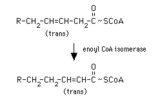 |
enoyl CoA isomerase reaction | Enoyl CoA isomerase converts a trans-3-enoyl CoA to a trans-2-enoyl CoA. Thus a Delta-9 fatty acyl CoA or the product of the 2,4-dienoyl CoA reductase reaction can proceed through beta-oxidation. | Enoyl CoA Isomerase Reaction | Knowledge Weavers Fatty Acids |
| 125 |
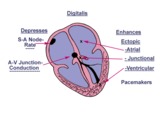 |
Diagram: digitalis effect on rhythm and conduction | Diagram: digitalis effect on rhythm and conduction | Knowledge Weavers ECG |
